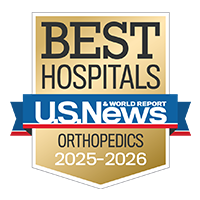Osteoarthritis of the Hand

Overview
Osteoarthritis is a degenerative joint disease in which the cushioning cartilage that covers the bone surfaces at joints begins to wear out. It may be caused by simple "wear and tear" on joints, or it may develop after an injury. Arthritis of the hand can be both painful and disabling.
Our Approach to Osteoarthritis of the Hand
When treating osteoarthritis in the hands, our goals are to relieve pain and restore function. We begin with nonsurgical approaches, such as physical and occupational therapy and medications. If these prove ineffective, surgery may be necessary.
UCSF's team of highly trained orthopedic surgeons includes specialists in the hand, wrist and arm. Using the latest techniques and technology, they offer options ranging from removal of excess bone to joint replacement.
Awards & recognition
-

Among the top hospitals in the nation
-

Best in Northern California and No. 6 in the nation for orthopedic care
Signs & symptoms
Symptoms include stiffness, swelling, loss of motion and pain. Bony nodules, which are small knots or swellings, may develop. When at the middle joint of one or more fingers, these swellings are called Bouchard's nodes. When located at the fingertip, they are called Heberden's nodes. The joints become enlarged and the fingers crooked.
Diagnosis
Your physician may begin by asking you to describe your symptoms, and when and how the condition started. Your physician can give a better assessment if you give a good description of pain, stiffness and joint function, and how these symptoms changed over time. It also is important for your physician to know how the condition is affecting your work and daily life. Finally, your physician needs to know about other medical conditions and whether you are taking any medicines.
X-rays may show such things as cartilage loss, bone damage and bone spurs. There is often a big difference between the severity of osteoarthritis that the X-ray shows and the degree of pain and disability you have. X-rays may not show early osteoarthritis damage before much cartilage loss has taken place.
Treatments
Treatment is designed to relieve pain and restore function. Anti-inflammatory medications such as aspirin or ibuprofen may help reduce swelling and relieve pain. Prescription medications or steroid (cortisone) injections may be recommended. Your physician may refer you to a physical or occupational therapist because changing the way you do things with your hands may help relieve pain and pressure. If conservative measures fail, surgery may be necessary. Several surgical options are available:
- Surgery may be used to drain or remove the cysts associated with the nodes and to remove excess bone growth.
- Joint fusion, a way of stiffening the problem joint, may be used to correct deformities that interfere with function or that are cosmetically unacceptable.
- A joint replacement may be advised.
UCSF Health medical specialists have reviewed this information. It is for educational purposes only and is not intended to replace the advice of your doctor or other health care provider. We encourage you to discuss any questions or concerns you may have with your provider.









